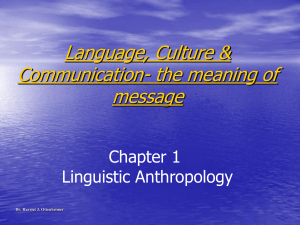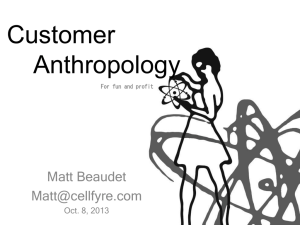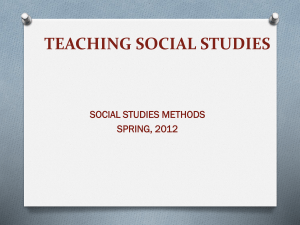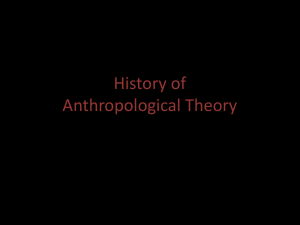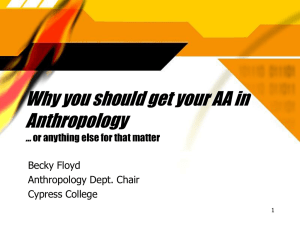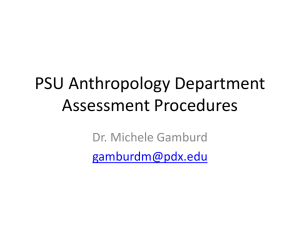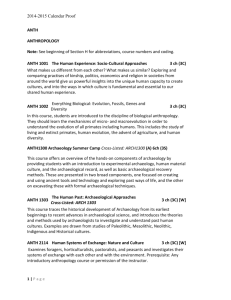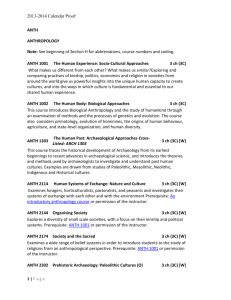Proposal
advertisement
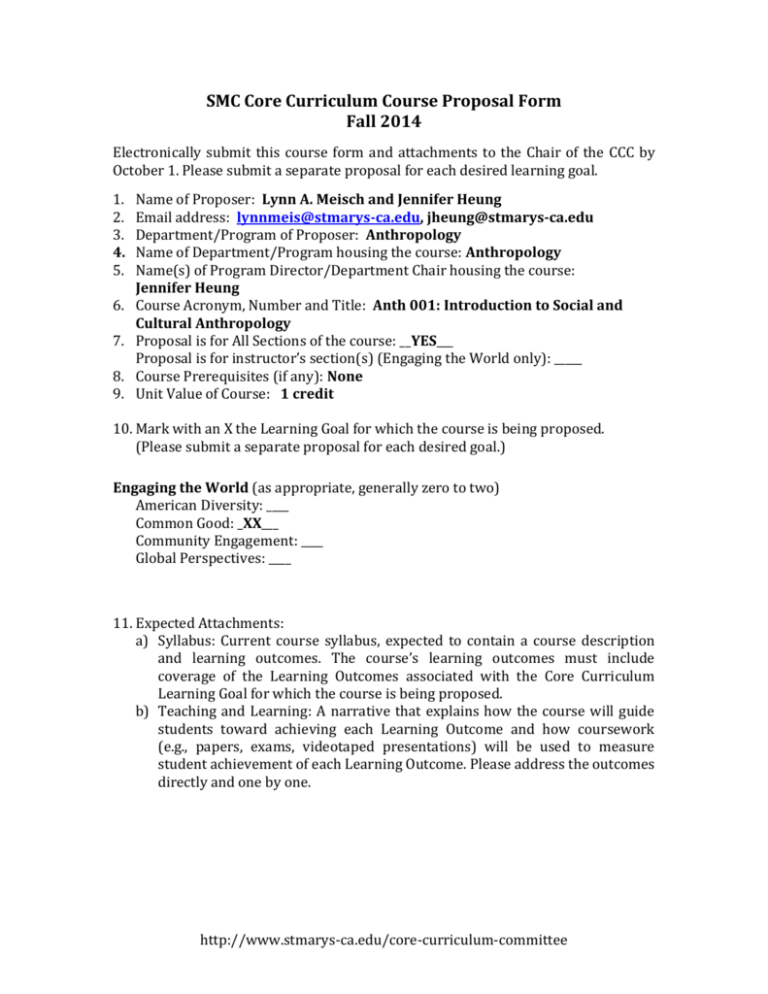
SMC Core Curriculum Course Proposal Form Fall 2014 Electronically submit this course form and attachments to the Chair of the CCC by October 1. Please submit a separate proposal for each desired learning goal. 1. 2. 3. 4. 5. 6. 7. 8. 9. Name of Proposer: Lynn A. Meisch and Jennifer Heung Email address: lynnmeis@stmarys-ca.edu, jheung@stmarys-ca.edu Department/Program of Proposer: Anthropology Name of Department/Program housing the course: Anthropology Name(s) of Program Director/Department Chair housing the course: Jennifer Heung Course Acronym, Number and Title: Anth 001: Introduction to Social and Cultural Anthropology Proposal is for All Sections of the course: __YES___ Proposal is for instructor’s section(s) (Engaging the World only): _____ Course Prerequisites (if any): None Unit Value of Course: 1 credit 10. Mark with an X the Learning Goal for which the course is being proposed. (Please submit a separate proposal for each desired goal.) Engaging the World (as appropriate, generally zero to two) American Diversity: ____ Common Good: _XX___ Community Engagement: ____ Global Perspectives: ____ 11. Expected Attachments: a) Syllabus: Current course syllabus, expected to contain a course description and learning outcomes. The course’s learning outcomes must include coverage of the Learning Outcomes associated with the Core Curriculum Learning Goal for which the course is being proposed. b) Teaching and Learning: A narrative that explains how the course will guide students toward achieving each Learning Outcome and how coursework (e.g., papers, exams, videotaped presentations) will be used to measure student achievement of each Learning Outcome. Please address the outcomes directly and one by one. http://www.stmarys-ca.edu/core-curriculum-committee Anth 001 – Introduction to Social and Cultural Anthropology Meisch and Heung, Fall 2014 Application for Common Good Teaching Narrative: Our Introductory course fulfills all three learning outcomes for the Common Good, but we emphasize two in our Intro courses: 1. Reflect and write substantively on ways in which human beings find fulfillment in community. 3. Demonstrate a capacity for coherent, principled analysis of concrete social problems. Anthropology is the holistic and comparative study of human diversity and is related to both science and the humanities. It consists of four subfields: Cultural and Social Anthropology (the subject of this application), Physical Anthropology (the study of human evolution and primatology), Linguistic Anthropology (the study of the origin and use of human languages) and Archaeology (the study of humans in relation to the past). Cultural and Social Anthropology is based on several basic concepts that speak to the LOs related to the Common Good. The first is the fundamental psychic unity of all humans, meaning that despite substantial differences in social organization, all cultures are a window on what it means to be human. In this sense, anthropology examines the way in which all humans find fulfillment and belonging within their own cultures. The second concept is ethnocentricity, the propensity to judge other cultures, usually negatively, based on your own, and to see your own culture as right, natural, and normal. Ethnocentricity is learned and can be unlearned. The ability to realize your own ethnocentricity is one of the goals of our course, and increasingly important in multicultural societies such as the United States. Indeed, a basic premise of Anthropology is that all human cultures have value and are worthy of respect. Both of these principles readily speak to LO#1 in understanding how individuals can find satisfaction and self-realization in different types of communities. During the course students are introduced to numerous crosscultural perspectives on community and the different ways belonging can be defined. The third concept central to Anthropology is cultural relativism, which does not mean that anything goes, that, for example, the Holocaust or the recent ISIS beheadings are, "just people doing their thing," but that we should try to see other cultures as a whole and attempt to understand them from the point of view of the members of those cultures. We ask our students to understand the cultural logic http://www.stmarys-ca.edu/core-curriculum-committee within a given culture that would explain behaviors and actions that one might otherwise find objectionable. The term emic refers to the insiders' view, while etic refers to the outsiders' view. These concepts do not excuse or justify racism or drug abuse or other social dysfunctions but give anthropologists and our students a framework to analyze numerous cultural concepts such as community, social order, and social justice. In this manner, students are then asked to identify and analyze social problems within a cross-cultural context (LO#3). Furthermore we ask our students to examine and seek appropriate solutions to social problems based on a thorough understanding of the specific culture under study. Every member of the SMC Anthropology Department teaches the introductory course on a rotating basis, and we also use lecturers when needed. Anthropologists generally have both area and topical specialties. (The topical specialties are not necessarily linked to the professor's area specialty.) For example Prof. Heung's area specialty is contemporary Chinese culture and society, and her topical specialties include globalization, identity construction, gender and migration, and urban anthropology. Prof. Meisch's area specialty is South America, and her topical specialties include material culture (especially dress and ethnic identity), indigenous rights, traditional healing, globalization, and museum studies. We achieve pedagogical cohesion in the introductory courses, while allowing professors to use their unique specialties, by having core reading and assignments for all sections of Anth 001 classes. These core components are: 1. A basic introductory textbook, Culture Counts: A Concise Introduction to Culture Anthropology by Serena Nanda and Richard L. Warms. Belmont, CA: Wadsworth Cengage Learning, Second Edition, 2012. The Nanda and Warms textbook covers the core Anthropological concepts with chapters on such topics as Marriage, Family and Kinship, Religion, Inequalities: Race and Ethnicity, Inequalities: Class and Caste, and Political Organization, to list a few. 2. An ethnography, meaning a book-length, detailed study by an anthropologist of a particular culture, subculture or social issue. For our intro course we use In Search of Respect: Selling Crack in El Barrio, by Philippe Bourgois. Cambridge, England: Cambridge University Press. Second Edition, 2003. The Bourgeois ethnography analyzes how social and economic circumstances (e.g. loss of manufacturing jobs in New York, poor education, broken families, and lack of affordable housing) marginalized Spanish-speaking Puerto Rican immigrants in East Harlem. The author lived in the barrio and researched how such conditions contributed to the crack cocaine epidemic in New York City in the 1980s and '90s by living in the barrio and conducting extensive research with crack dealer. 3. A written review of an article of the students' choice from an Anthropological journal and an outside event assignment. Both these common assignments ask http://www.stmarys-ca.edu/core-curriculum-committee students to apply anthropological concepts such as cultural relativism and ethnocentric to events and issues outside of the classroom. Learning: LO#1: We measure the students’ mastery of this LO in quizzes, tests, or short critical reflection papers administered at numerous points throughout the semester. This form of assessment requires students to articulate in written form how individuals in different cultures define and recognize community and the culturally appropriate ways in which one finds fulfillment in these groups. The concept of “fulfillment” is also investigated to examine the different ways individuals can gain a sense of belonging through various categories such as racial identity, social class, cultural continuity etc. In addition there are numerous in-class activities that help students reflect on these different cultural definitions of community and how individuals enact the cultural logics of belonging in diverse manners. For example, after different units of the class (e.g. political organization, marriage, family and kinship, or religion) students will be assigned critical reflection papers that ask them to use the readings to reflect on the ways humans find fulfillment in community through different cultural means. Additionally another professor uses classroom debate in which students are divided into smaller paired groups, which must assume the personas of people in the book (In Search of Respect: Selling Crack in El Barrio). Students must speak in the first person and justify their actions (as described in the book). One group represents the people of El Barrio, the other the police, drug enforcement personnel, school teachers and so on. The class members not debating vote on who won the debate, based not on political correctness but on which side made the best arguments. In all the sections, students write and reflect on this LO continuously in different formats. For example, on quizzes they are asked to give short answers and on exams students may write longer reflective essays. During in class activities students may be asked to free write reflective essays and student also can have short assignments as described above. This learning outcome of how humans find fulfillment in community is central to anthropology and students write and reflect consistently on these ideas. By the end of the semester, students will have numerous opportunities to produce written work regarding this LO. For Core assessment purposes, there will be several different written assignments from which to draw upon for data regarding the Common Good. Instructors who elect to use the debate format described would be happy to have the debates filmed for assessment purposes. LO#3: Throughout the course students explore many forms of inequality and social justice in a cross-cultural context. Not only do we have students demonstrate their understanding of social problems through various categories of difference (e.g. race, class, gender, sexuality, religion, and nationality), they are also asked to compare and contrast a US understanding of these problems with other cultures presented in the course. For example, how do issues of social inequality manifest differently in http://www.stmarys-ca.edu/core-curriculum-committee nomadic vs industrialized societies? Or how does a county with a socialist government deal with an informal drug economy? In each cultural context, students must understand and be able to articulate how a particular social problem is defined and then analyze the social problem from an emic and etic perspective. These forms of comparisons and articulations of social problems in a cross-cultural context may be assessed by different formats that may include multiple quizzes with written responses, essay questions on exams, and reflection papers in the classroom or given as assignments. Again, for Core assessment purposes, there will always be at least one written assignment, and usually more, that will be sufficient for data collection purposes. http://www.stmarys-ca.edu/core-curriculum-committee
